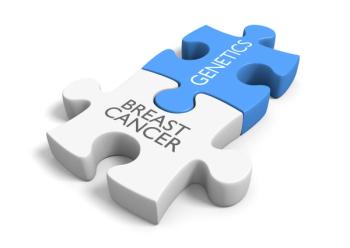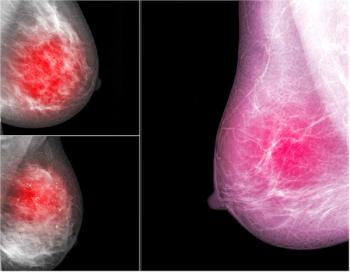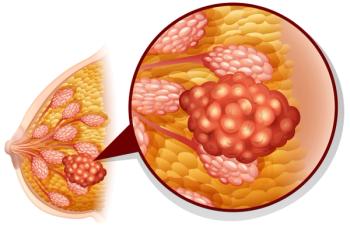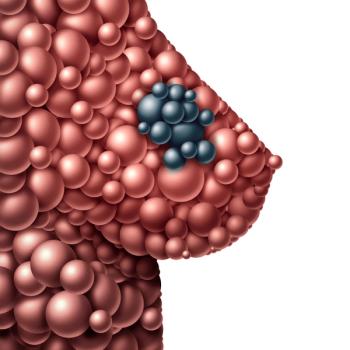
Breast Cancer
Latest News

Latest Videos

CME Content
More News

Meeting HHS’ minimum requirements for daily and weekly exercise reduced breast cancer recurrence and mortality among patients with high-risk breast cancer undergoing chemotherapy. This benefit was even seen in patients who had not met these requirements before their diagnosis.

The standard therapy for triple-negative breast cancer (TNBC) remains chemotherapy, despite a dismal prognosis due to lack of estrogen and progesterone hormone receptors, as well as HER2 receptors. Targeted therapies for this difficult-to-treat, often aggressive, subtype of breast cancer remain elusive.

What can be done to further delineate the risk factors associated with breast cancer to increase prevention efforts across the board? The key may lie in the white blood cells that circulate in the blood, particularly leukocytes and monocytes.

The 2 main criteria that warrant genetic testing for breast cancer in women are age and having a family history of cancer. Postmenopausal women without any hereditary risk factors, however, often do not undergo genetic testing for the disease.

Not all women with dense breast tissue have a high risk of breast cancer, but they all have an increased risk compared with women who have average tissue density. Can this patient population benefit from screening with abbreviated breast magnetic resonance imaging (AB MRI) over digital breast tomosynthesis?

Two hormone-modulating breast cancer therapies (HMTs), tamoxifen and steroidal aromatase inhibitors, were associated with a decrease in the number of women who received a diagnosis of a neurodegenerative disease, according to a study published in JAMA Network Open. Specifically, the 2 HMTs were associated with significant decreases in diagnoses of Alzheimer disease and dementia.

Patients who undergo neoadjuvant chemotherapy tend to be younger, with larger tumors and greater nodal involvement. But differences in their 30- and 90-day mortality rates compared with those of patients treated adjuvantly are clinically insignificant.

Investigators tracked time to treatment for 3 types of cancer in states that expanded Medicaid coverage on January 1, 2014, comparing rates before and after the expansion. Patients with new diagnoses of invasive breast, colon, or lung cancers aged 40 to 64 years were included in the analysis.

Thirty-seven percent of women prefer to receive their lifetime risk of breast cancer through numbers and words, while 73% prefer a combination of lifetime and 10-year age-related risk.

Of the women in the 2017 study over age 75, 63% had a mammogram.

Mammography Screening Improves Outcomes Among African American and White American Patients With TNBC
Screening mammography is important for reducing race- and ethnicity-associated triple-negative breast cancer (TNBC) disparities among African American and white American patients. At present, there is a 40% higher mortality rate among African American women compared with white American women.

Recommendations abound for when women at average risk for breast cancer should begin yearly mammography screening, ranging from age 40 to 50. Questions remain, however, on the optimal age at which to stop. However, with over 50% of women older than age 75 still undergoing mammography, is there a truly safe age at which to stop what has been shown to be a life-saving practice if it does not decrease their mortality from breast cancer?

When time to first treatment ranged from 31 to 90 days for patients with breast cancer, doctors had more time for extensive diagnostic workups without compromising survival rates.

The 5-year survival rate for triple-negative breast cancer (TNBC) is about 77%. The recurrence rate is highest in the first 3 years after treatment, but falls off at the 5-year mark—although the survival rate at this time point tends to be lower. Because TNBC cells lack the hormone receptors for estrogen and progesterone and do not overexpress the human epidermal growth factor receptor 2 gene, treatment often involves chemotherapy, radiation, and surgery. Targeted treatments are not used with TNBC.

CMS said it is expanding coverage of next generation sequencing (NGS) for use as a diagnostic for patients with germline breast and ovarian cancer, paving the way for Medicare beneficiaries to receive more personalized medicine. However, an advocate said the wording of CMS' decision could actually limit testing access for some women with breast or ovarian cancer.

There are new technologies that allow for genetic counseling services through which the provider does not even need to get that involved in the process, said Banu Arun, MD, medical oncologist, Department of Breast Medical Oncology, Division of Cancer Medicine, MD Anderson Cancer Center.

Listening to patient concerns and issues and communicating with them can really help providers keep patients with breast cancer adherent to their hormonal therapies, said Erica Mayer, MD, MPH, assistant professor, medicine, Harvard Medical School.

Two abstracts on liquid biopsy tests revealed the potential of analyzing circulating tumor DNA (ctDNA) and circulating tumor cells (CTCs) in promoting heightened decision-making by clinicians for patients with early-stage and metastatic breast cancer.

In phase 3 trial results presented at the San Antonio Breast Cancer Symposium in San Antonio, Texas, oral paclitaxel with encequidar, the first orally administered paclitaxel, was shown to exhibit superior confirmed response and survival with less neuropathy for patients with metastatic breast cancer compared with intravenous (IV) paclitaxel.

Rita Nanda, MD, associate professor, medicine, The University of Chicago Medicine, outlines the design of the I-SPY2 clinical trial and what the results have been so far.

Ensuring that prognostic or predictive tests to help make decisions regarding radiation therapy are accurate and clinically validated remains a challenge, said Corey Speers, MD, PhD, assistant professor, radiation oncology, University of Michigan.

Data from the MINDACT trial revealed that among women with luminal breast cancers (hormone receptor–positive, HER2-negative by local pathology) with a high clinical risk and low genomic risk, those aged 40 to 50 years had a greater, but insignificant, benefit from chemotherapy than patients older than 50.

The bar for who should get genetic testing for breast cancer keeps getting lowered, and oncologists have to keep informed about which results should trigger a referral for germline testing, said Nadine Tung, MD, director, Cancer Risk and Prevention Program, Beth Israel Deaconess Medical Center, and associate professor, medicine, Harvard Medical School.

Using biomarker tests can help personalize care for women with ductal carcinoma in situ and determine the risks of using or not using radiation, said Eileen Rakovitch, MD, MSc, FRCPC, professor, department of radiation oncology, University of Toronto.

In 3 abstracts presented at the San Antonio Breast Cancer Symposium in San Antonio, Texas, patient-reported outcomes (PROs) and quality of life were measured for different therapeutic interventions aiming to either heighten tumor detection or ease chemotherapy-induced effects.















































